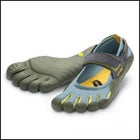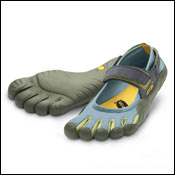Greetings, far-away reader! The global reach of the Gear Guy truly is a wonder.
Vibram FiveFingers Sprint
 FiveFingers Sprint, one of hundreds of Vibram products on the market
FiveFingers Sprint, one of hundreds of Vibram products on the marketAnd you wonder about . For starters, Vibram is a brand name, its not a material (and for the record, its pronounced Vee-bram”). Its worth remembering that for many years, climbers wore awkward hob-nailed bootsboots with slick leather soles given traction by driving a variety of sharp objects (the hobnails) into them. These worked pretty well on soft ground, but no so well on rock (climbers were taught to use hobnails around the edge of the sole as hooks to grab small edges in rock not a very secure way to climb).
In 1935, Italian mountaineer Vitali Bramani led a climb in which he and his partners started out with hobnailed boots, but switched to lighter footwear for the final summit push. But when fog and a blizzard hit the group, these boots prevented the climbers from moving over the slick terrain, and gave little protection from the cold. Six of them died.
So, Bramani decided to create a sole material that would work well on both hard and soft surfaces. He came up with a lugged sole (for soft terrain) made from a durable rubber compound that gripped rock well, and called it Vibram in a contraction of his name.
Today the Vibram company makes all sorts of different soles for hikers and climbers, varying the composition of the sole for better wear or better grip, and designing different lug patterns to accommodate everything from day hikes to vertical rock and ice. Although some boot companies, such as Salomon, make their own soles that are very good, Vibram is sort of the gold standard, and its soles are widely used today.
So thats the word about Vibram!
The 2008 Summer ���ϳԹ��� Buyers Guide is now on newsstands. Look for it online soon.


